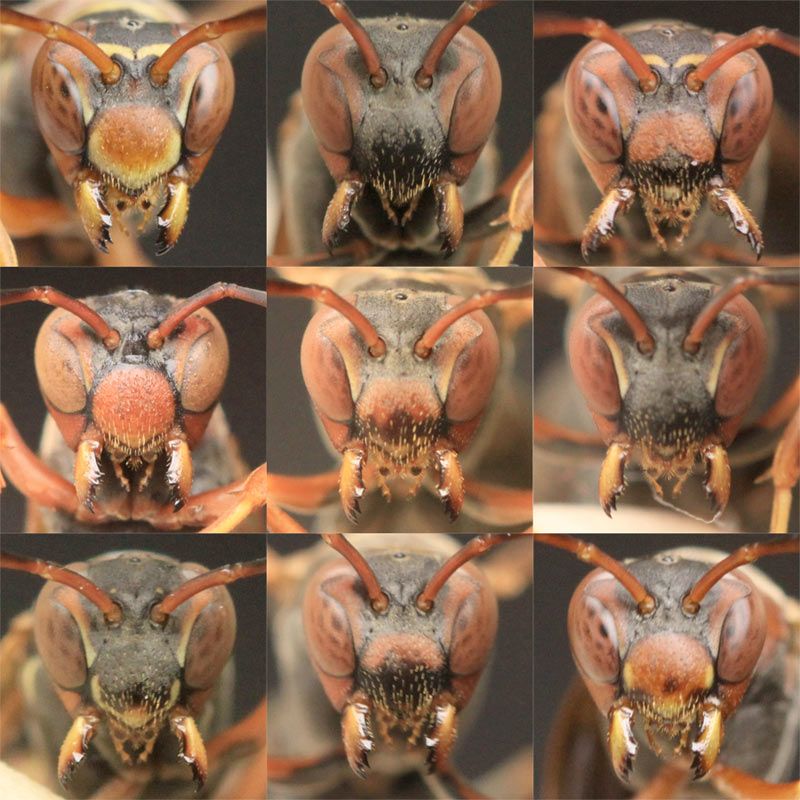Wasps Wired to Recognize Each Other's Faces

A species of paper wasp has a special talent for recognizing faces of its own kind, shows a new study.
Scientists have long known that the wasp Polistes fuscatus can distinguish individuals in its colony by recognizing facial markings. In the new study, researchers found that the wasps learn to identify images of P. fuscatus faces faster and more accurately than other types of images.
This is the first time that scientists have discovered this humanlike ability in an insect.
"It appears that something we seem to think is so complicated — specialization for facial recognition — is something that can emerge separately in really diverse species," said David Leopold, a visual perception researcher for the National Institute of Mental Health, who was not involved in the study.
Facial recognition
In a single colony of P. fuscatus, there are often multiple groups of wasps led by cooperating queens. By constantly battling each other, the queens set up a power structure in the colony, determining food distribution, work assignments and reproductive privileges.
Each wasp has distinct markings on its face and abdomen. "They are strikingly different, like snowflakes," lead researcher Michael Sheehan, a graduate student in evolutionary biology at the University Michigan, told LiveScience. [See photos of wasp faces]
Sign up for the Live Science daily newsletter now
Get the world’s most fascinating discoveries delivered straight to your inbox.
In 2002, Sheehan’s adviser, Elizabeth Tibbetts, discovered that the wasps use the markings to identify individuals and to sort out others' rank. When Tibbetts painted yellow markings on a wasp, the insect suffered considerable aggression from former colony friends, though not as much as if it were an actual invader. The wasps knew by scent that the painted insect was a nest mate, but they couldn't recognize the insect by appearance and were unsure if it posed a threat to rank. Eventually, the wasps were able to learn the facial markings and assign a rank.
For the new study, Sheehan and Tibbetts assessed P. fuscatus'ability to learn new faces compared with other images. "We [humans] learn faces differently than we process every other type of visual stimulus, even though there's nothing special about the light bouncing off of a face," Sheehan said. The same sensitivity to faces is true of other animals, including some primates and sheep, but no insects have made it on the list.
To find out if paper wasps had the ability, the researchers set up a T-shaped maze and electrified the entire floor except for one arm of the maze. They placed an image of a P. fuscatus face in an electrified wing, and a different P. fuscatus face in the safe wing, which changed locations with each trial. They trained 12 wasps to associate one of the faces with safety.
They then repeated the experiment using different paired images, including simple black-and-white shapes, caterpillars (their food), antenna-less faces, rearranged P. fuscatus faces and faces of a closely related paper wasp, Polistes metricus.
They found that the wasps were able to discriminate between the normal P. fuscatus faces much more rapidly and accurately than any of the other images, suggesting that the insects have evolved specialized face-learning abilities."The eyes and brains of wasps and mammals are very different," Sheehan said. "There's just something about recognition in individuals that really favors specialization learning."
The researchers also performed the experiment with P. metricus wasps, which don't form multiqueen colonies, and found that the species does not learn faces any better than other images.
Perception or behavior?
Leopold agrees that the wasps have specialized face learning, but wonders if it has more to do with face perception or behavior. Perhaps the wasps can distinguish other things, such as shapes or rearranged faces, but they don't respond to these with changed behaviors.
"It may be that they are really not that bad at discriminating the other images, but they just don't behave in a selective way,” he said.
Whatever the case, "I'm really happy that some investigators are thinking comparatively about high-level face recognition," Leopold said. He points out that in mental health disorders, people are often unable to pick up on subtle facial cues. "If we had a broader understanding of how facial recognition works, we would be better off," he said.
The study will be published in the Dec. 2 issue of the journal Science.

Most Popular


